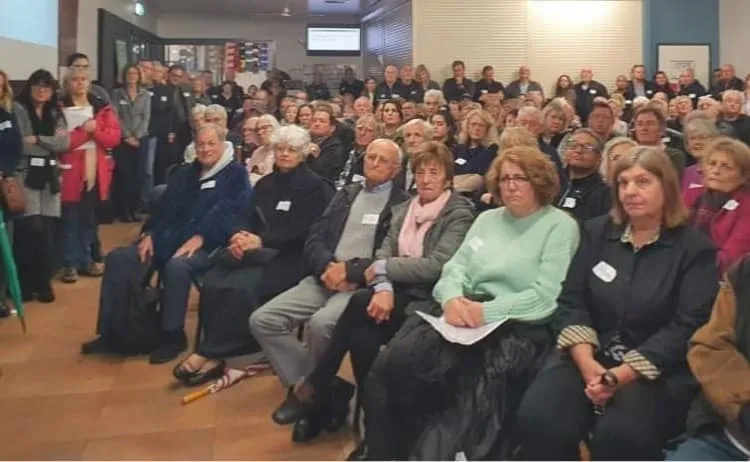FAQs
During our three-year journey in opposing The Vines (WA) Pty Ltd's redevelopment plan, The VRRA have been asked many questions. Here are the most frequently asked questions with our answers.
1. As a private business, don’t The Vines (WA) Pty Ltd have the right to make changes to their operations without permission of customers and adjacent property owners?
To a degree. However, like everyone else, The Vines (WA) Pty Ltd have obligations as land users and within the community. Without launching into the need to comply with a range of legislation, we should remember why The Vines was developed and subsidised by the government and the reasonable expectations of those that invested in that development.
• The Vines was a late 1980’s joint venture between the WA State Government and a Japanese company, Sanwa Vines Landholding, who were the owners of the resort until 2005.
• The Vines development was state sponsored, for growth in tourism and business with Japan. Public and tourist access to an international competition-standard golf course was guaranteed.
• Planning requirements were defined for a golf course surrounded by areas zoned for housing. City of Swan Local Planning Scheme 17 Schedule 4 Section 3 stipulates “Special Use Tourism and Recreation Resort” and has specific requirements on The Vines (WA) Pty Ltd. The Vines Outline Development Plan no 37, (the local Structure Plan), “seeks to maximise the number of residential homesites with direct aspect of the golf course and increase the number of homesites with secondary views of the golf course”. And the ODP objectives are clear on design and intent of maintaining the unique ”natural attributes and physical features” of The Vines.
• The marketing of residential land around the golf course stated views and had premiums on land and building design commensurate with that location.
The present resort owners, The Vines (WA) Pty Ltd, should not ignore this history, the support, and benefits from the state government and the community.
2. Why not support the changes of “an upgraded 18-hole championship course”, “a 14-hole short course and state-of-the-art driving range” that were stated in the media release of 13th May 2024 by the owners of The Vines?
Of course the community would support genuine upgrading. However the proposed changes would be detrimental to the existing amenity. These are some of the reasons:
• There is no evidence yet of professional design to the changes
• The move to a "Championship Course”, and proposal to squeeze an imposing two-storey driving range structure plus short course into a functional 9-hole course, reduce the golfing standards and amenity. Although alternative layouts are known, they have not been publicly presented to allow the community to give input.
• The placing of the driving range on the 9th hole of the Lakes course was rejected in an earlier development application to the Metro Outer Joint Development Assessment Panel (No 243 of April 2023), for reasons that can’t be ignored.
• Once lost, there is almost zero chance to recover the two 18-hole courses.
There is no realistic chance that land will be available for any new golf course in this area in the future.
3. What happens if The Vines (WA) Pty Ltd are successful in applying to amend The Vines Structure Plan (Outline Development Plan, ODP no 37), such that the ODP will show the redevelopment proposals for Lot 1003 Verdelho Drive?
As Lot 1003 Verdelho Drive covers all the golf open spaces including the existing driving range, any Planning changes on a part of that Lot will potentially enable similar changes to the rest of the land in the future.
• If the application is for a scheme amendment to rezone the existing driving range area from Rural to Urban and to permit R-codes for residential construction of ‘Over 55' housing then, unless the rest of Lot 1003 is specifically excluded, that change can in the future be applied to the rest of the open golf areas (rest of Lot 1003).
• Alternatively, if there is an exclusion on the other parts of Lot 1003, the fact that one part has successfully been changed sets a precedent for future similar changes across other parts of Lot 1003.
4. What are the Environmental and Ecological values of The Vines that are being threatened?
Whatever development footprint is proposed, it must be considered under the context of the greater area of The Vines given that:
• The Vines is a complex and highly significant environment, in terms of its natural, and indigenous cultural heritage values.
• The Vines includes many values listed under WA State and/or Federal, environmental protection and biodiversity conservation legislation.
• The Vines as a whole also provides linking corridors between Class 1 Reserves (Bush Forever sites), nature reserves and waterways.
The VRRA's Environmental Assessment for the earlier JDAP application for a new two-storey driving range and associated amenities showed:
1. The location of the golf course footprint is on the highly cleared, eastern Swan Coastal Plain where the few remaining areas of native vegetation are very biodiverse and include rare elements.
2. The complexity of the bio-physical and indigenous heritage environment requires independent and appealable assessments by the WA EPA and the Australian Government Department of the Environment and Energy (DEE) .
3. The numerous EPA, ‘Key Environmental Factors’ and DEE ‘Matters of National Significance’ that the current wider redevelopment proposal was likely to impact included:
a. Vegetation Complexes of the eastern Swan Coastal Plain (especially the Swan Vegetation Complex) [of which, only 0.39% remains];
b. Threatened Ecological Communities (TECs) that were evident from the DBCA, database search results including Tuart open forest that met the criteria for the Eucalyptus gomphocephala (Tuart) woodlands and forests of the Swan Coastal Plain. This Tuart ―TEC, will be damaged by the proposed driving range fence construction. This Tuart TEC occurrence had numerous, additional, positive characteristics that increased its conservation significance which cannot be ignored.
c. the unique Ellenbrook, consanguineous wetland suite that is poorly represented in the secure, conservation estate.
d. Threatened Fauna (three species of Black Cockatoo) and their critical (forage, potential breeding and/or roosting) habitats.
e. Priority 4 fauna (Quenda)
f. High, flora species-richness and rarity values of The Vines including the largely intact, fringing vegetation of the permanent watercourse that is intersected by the proposed Driving Range.;
g. Ecological connectivity (between two important Bush Forever Areas―BFA 23 and BFA 301,
h. Hydrological factors that maintain the perennial, channel wetland (classified as a leptoscale river) that is intersected by the proposed Driving Range.
i. the indigenous heritage of the registered Aboriginal Heritage Site 3525 (Ellen Book Upper Swan) which is of mythological significance for Turtle Dreaming and the Waugal (the main figure of the Nyungar creation beliefs);
j. One of the two last natural* refuges of the Critically Endangered Western Swamp Turtle (at Ellen Brook and Twin Swamp Reserve) is closely connected to the leptoscale river that is intersected by the proposal footprint. There is a recorded example of the Western Swamp Turtles travelling between Reserves. It is also highly likely that the Ellenbrook waterways are accessed on occasion.




